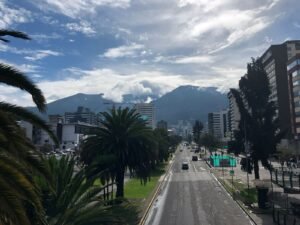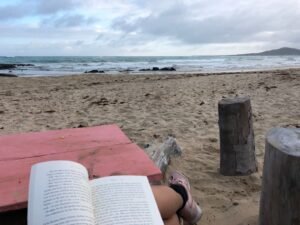
In 2018, when I was 22-23 years old, I lived and worked in the Galápagos Islands for one year. The islands are a fantasy, and sometimes just hearing a song, seeing a photo, or noticing an accent, can fill me with heartache and nostalgia for the time I spent there.
Here, I will outline how I came to live and work in the Galápagos, and what my experience was like.
Working on the Galápagos Islands
Before going to the Galápagos, I already had a job set up.
I had a contract with a private English school for children and adults on the islands. I had found the

job through an online job posting, and in order to get hired, I had to have an English as a Second Language (ESL) teaching certification.
I had a CELTA certification, and you can also get a TEFL certification through a pretty simple online process but getting a CELTA is more intensive and I felt it prepared me much more for the real process of teaching ESL. I also had an online interview, and I submitted a copy of my B.A. in English and my resume.
If you’re interested in working on the islands, being an English teacher is a good avenue to do so, because much of the local economy depends on tourism, so there is a lot of demand for learning English, and various schools that meet that demand.

After I was hired, the school set me up with a lawyer and I booked my flight to Quito, the capital of Ecuador, so that I could start the visa process.
I met with the lawyer in Quito and for a few weeks I stayed at a hostel with one other friendly coworker while we went through the visa process.
Technically, the entirety of the Galápagos Islands are a national park, so upon arriving you will pay a $100 entrance fee to get into the park. That amount can be waived if you have a work visa and a valid work contract.
My boss emailed me a document that I used to waive the fee every time I entered the national park, but once I forgot it and I was able to show the woman working at the airport my work contract and she printed out a new one for me. I also needed a return flight to go home in order to get my visa, but if you don’t know when you will be returning you can print out a temporary ticket at the airport.
Documents Needed to get a Work Visa in Galápagos
In order to get my work visa to get onto the islands, I needed the following documents:
- A state criminal background check
- A federal criminal background check
- A non-expired passport with at least two blank pages
- Copies of my university degree and transcripts
- My work contract to be in Galápagos and copies of my work contract
- Copies of my passport
- Four valid passport-sized photos (I ended up not needing these to get into Ecuador, but I used them years later when I lost my passport in Argentina!)
- All of the above had to be apostilled. In order to get apostilled stamps, I had to drive to my home state’s capital before leaving the states (my mom drove me there, thank you, mom!) and get them all reviewed and stamped. I believe they requested apostilled translations to Spanish as well but I didn’t have time to get those and I was fine.
With our lawyer, we had various meetings and interviews in a few government buildings (with long lines) and they took our photos. Typically, the lawyer spoke for us, especially because my Spanish was basic at that point in time.

Galápagos Phone Plan
While I was in Quito, I also got an Ecuadorian phone number and SIM card, which I did just by walking into the nearest cellphone carrier building, Claro. Claro is the biggest cellphone carrier in Ecuador, and there is a Claro office in Puerto Ayora in the Galápagos, so you can get a new phone plan on the islands and you can do a pay-as-you-go plan either in Claro or in various Internet cafes on the islands. Keep in mind that even if you have an internet plan, it will not work on many parts of the islands.
If you are only going for a short trip, then you don’t need a phone plan and you can use WhatsApp when you are hooked up to Internet, but to live on the islands for a year, I wanted a solid phone plan.
Once my Visa was approved, I booked my flight to the islands.

Getting to the Galápagos Islands
When you book a flight to the Galápagos, you will fly from mainland Ecuador, either from Quito or Guayaquil, to either the Seymour Airport on Baltra Island, or the San Cristóbal Airport on San Cristóbal Island. I only ever flew into the Seymour Airport because I lived on Santa Cruz Island in Puerto Ayora. There are also many more flights available to the Seymour Airport instead of San Cristóbal.
Cristóbal.
Santa Cruz has the largest population in the Galápagos, with most people living in Puerto Ayora, a city at the southern end. To arrive at Puerto Ayora, you will take a flight to Baltra, a bus through Baltra, a boat from Baltra to Santa Cruz, and either a bus or taxi down the highway that goes through Santa Cruz down to Puerto Ayora at the bottom (the bus is cheaper and takes the same route, so it’s best to take the bus). If you look closely on the way in through the highlands, you’ll catch a glimpse of giant tortoises and other famous Galápagos wildlife!
What is the currency on the Galápagos Islands?
All of Ecuador operates in U.S. dollars, so if you are coming from the states, you will not need to exchange your money. However, I would recommend bringing a significant amount of cash because some islands do not have ATMs. My family and I learned this the hard way in Isabela once and had a luxurious night of splitting a pack of Oreos for dinner because we had run out of cash.
For information about packing and what to bring, I found this list quite helpful, plus the photos from their Galápagos trip are beautiful.
What is it Really Like to Live in the Galápagos?
When I moved out of Pennsylvania and the U.S. and got to islands, I lived in a room above the school where I worked.
My paycheck was $800 a month, with a portion taken out monthly for health insurance. All accommodation was included in my work contract, so my earnings were just for food and they were more than enough for my lifestyle.
In my room, I had no Wi-Fi, but in the school there was some slow Wi-Fi available, so if I wanted to watch a movie or listen to music, I could often leave my phone charging overnight in the school with a movie or episode downloading, then the next day it would be ready to watch. I also spent a lot of time reading and writing.
reading and writing.
If you’re going to live in the Galápagos the way I did, you have to be ready to check out from the world.
And I really do mean check out.
It was a bizarre experience for me to come back to the mainland in 2019 and fashion and pop culture had changed while I was away. For example, I was taken aback to realize that all girls were suddenly wearing clunky boots like horse hooves.
Once after I got home from Galápagos, the song “Shallow” from A Star is Born came on the radio and I turned it up saying, surprised, “This is a good song! Who sings this?” causing the people who were with me to stare in disbelief because that song had been playing nonstop on the radio for a year and everyone was already sick of it.
While living in the Galápagos, I typically woke up with the roosters and took a cold shower (the hot water was off for most of the year, but it was often very hot and sunny outside so I didn’t miss hot water too much). I brushed my teeth with bottled water. I usually taught one class at 9 AM, then I had the afternoon free to go to La Estación which is the beach inside the Charles Darwin research facility and also the closest beach to the school.
 Sometimes I would eat lunch downtown at the café above Proinsular Market or Galapagos Deli where I loved to write.
Sometimes I would eat lunch downtown at the café above Proinsular Market or Galapagos Deli where I loved to write.
I could be back at the school by 3 PM for my afternoon classes, then I would teach until around 8 PM. I would then typically stay after class and work on my lesson plans for the next day.
You also can certainly find nightlife on the islands, and on weekends we would go to Bongo Bar or Santa Cruz Brewery. Bongo is better for dancing, and Santa Cruz Brewery is better for talking and relaxing. Both are pretty full of tourists, but there are also other bars a little bit further inland where locals go where you can dance bachata, salsa, reggaetón, etc.
Another option on weekends is checking out other islands. Once when I had a long weekend off work, I went on a writing retreat to Floreana, which is very sparsely populated. Other popular destinations are Isabela, the largest island, and San Cristobal where you can see an excess of sea lions. You can take a boat to these places for affordable prices, just be forewarned that the boat rides are often pretty choppy, so if you get seasick easily then you may need to take some medicine before leaving.
I went on a writing retreat to Floreana, which is very sparsely populated. Other popular destinations are Isabela, the largest island, and San Cristobal where you can see an excess of sea lions. You can take a boat to these places for affordable prices, just be forewarned that the boat rides are often pretty choppy, so if you get seasick easily then you may need to take some medicine before leaving.
Living with the Galápagos Animals
Before going to the Galápagos, my parents gave me the thoughtful gift of a book on Galápagos wildlife. As time went by, I marked up the book, annotating when I saw certain animals and where I saw them.
 (Most) visitors are respectful of the animals and keep their distance. For that reason, many of the animals have never learned that they need to be afraid of people, so there are sea lions sleeping on the park benches, giant tortoises wandering up the side of the roads, and baby sharks swimming around the docks.
(Most) visitors are respectful of the animals and keep their distance. For that reason, many of the animals have never learned that they need to be afraid of people, so there are sea lions sleeping on the park benches, giant tortoises wandering up the side of the roads, and baby sharks swimming around the docks.
When my Spanish improved and I started making local friends, I finally got to enjoy other activities like night swimming at Las Grietas and jumping off the cliffs into the Puerto Ayora harbor.
Pros and Cons of Living on the Galápagos
As I create this curated post, I hope I don’t idealize the experience that I had on the islands, because, while I adored my time in Galápagos as a whole, it wasn’t ideal and nothing is.
Giving up creature comforts was surprisingly easy, and I was able to adapt to things like no Wi-Fi quicker than I thought I would be able to. In fact, the lack of Internet connection turned out to be one of the best parts of the year on the islands, and I don’t know if I’ve heard and understood my personal thoughts quite so well since returning to the connected world.
The issues that I managed were unexpected. When I first got to Galápagos, my Spanish still needed a lot of work. This language barrier plus the fact that I was living in a popular tourist destination where many people come and go made me lonely, and that loneliness became a vulnerability that led me to put myself in a few dangerous situations. This is an unfortunate reality for any young person, especially young women, traveling alone, and it is true anywhere.
But another effect of that loneliness, especially without social media to distract myself, was a profound understanding of both useful and unproductive sides of myself, and eventually, the ability to genuinely enjoy my own company, which I can’t say is something I was able to do before.
Galápagos isn’t paradise, but it’s pretty damn close. More than once I was moved to tears of gratitude for the beauty of the natural life of the islands. By the end of my year living there, I believe that I had experienced divinity and inspiration in nature, and I worry about Galápagos the same way I would worry about a loved one who lives far from home.
Galápagos Environmental Dangers
SOS Galápagos shares relevant news about environmental threats to the islands, including not only climate change, but various other problems like Chinese fishing fleets, excessive tourism, and agriculture.
Below, I’ll also share a snippet from my book in which I explain why climate change is of particular concern in the Galápagos.
From the novel, Equator:
Fast Facts about the Galápagos Islands
– The Galápagos sit directly in the route of El Niño, a tropical storm that causes the ocean to warm quickly and extremely. As global temperatures rise, El Niño is becoming more frequent, and more destructive. In Galápagos, warmer waters mean fewer nutrients. Warm water kills algae, sardines, and other small fish, then the problem moves up the food chain to cause widespread starvation among sea lions, iguanas, and all Galápagos animals.
– The Galápagos iguanas have shrunk to accommodate having fewer sources of food as much of the algae they usually eat has died off in warming waters. Sea lions have also changed their hunting habits. When El Niño last hit the islands in 1982, an entire generation of sea lion pups died. The oceans have warmed half a degree Celsius since then.
– The population of the famous blue footed booby, a bird that feeds mainly on sardines, has been plummeting in recent years. Many other birds, including the Galápagos penguin, the northernmost colony of penguins in the world, stop breeding when water temperatures rise. After the islands were last hit by El Niño, eight out of every ten Galápagos penguins died.
– Agriculture in the highlands threatens native species and allows invasive species like the wild blackberry to thrive. The Galápagos Charles Darwin Foundation worries that the Scalesia forest of the highlands will not survive the rapidly growing agriculture of the highlands in recent years.
– Many animals of the Galápagos are endemic. Efforts are already being made to breed then release threatened animals, but many creatures cannot be bred in captivity. The Galápagos Islands are currently considered one of the places in the world at the highest risk of being destroyed by climate change.
While the above quote, like a lot of quotes about climate change, sounds abysmal, I want to clarify that Galápagos and Latin America as a whole have a chance with climate change to become thought leaders and inventors of the future.
Many places in the states and Europe are developed according to the old model, and in order to build a sustainable reality, we will first have to break down cultural trends and success models based on excess and waste before we can start building more effective and safe realities again. Places like the Galápagos are not largely developed, and they thus serve as ideal locations for building a sustainable model that can later be applied to the rest of the world.
I have enormous hope for the Galápagos, and I believe it could become a sustainable paradise in my lifetime. Galápagos, and the human race, must make the sustainability leap not in an attempt to create a utopia but simply in order to survive.
In that vein, I’d like to include a quote from Gabriel García Márquez’s 1982 Nobel Prize in Literature acceptance speech, because I could never dare to attempt to say it better than him:
Why is the originality so readily granted [to Latin America] in literature so mistrustfully denied us in our difficult attempts at social change?
In spite of…oppression, plundering and abandonment, we respond with life. Neither floods nor plagues, famines nor cataclysms, nor even the eternal wars of century upon century, have been able to subdue the persistent advantage of life over death. An advantage that grows and quickens: every year, there are seventy-four million more births than deaths, a sufficient number of new lives to multiply, each year, the population of New York sevenfold. Most of these births occur in the countries of least resources – including, of course, those of Latin America.
On a day like today, my master William Faulkner said, ‘I decline to accept the end of man.’
[W]e, the inventors of tales, who will believe anything, feel entitled to believe that it is not yet too late to engage in the creation of the opposite utopia. A new and sweeping utopia of life, where no one will be able to decide for others how they die, where love will prove true and happiness be possible, and where the races condemned to one hundred years of solitude will have, at last and forever, a second opportunity on earth.
If you want to donate to the Galápagos, the Galápagos Conservancy has a high rating as a trustworthy charity and they’re doing some important work taking care of the Galápagos critters.

Galápagos Frequently Asked Questions (FAQs)
Can you drink the water in the Galápagos?
In many places around the islands, the water that comes from the faucet in Galápagos is unfiltered and not drinkable, so you typically cannot drink the tap water in Galápagos without getting sick.
In fact, even when it seems like overkill, brush your teeth with bottled water, and dry your dishes completely before using them, because more than once I got stomach pain and diarrhea from accidentally consuming small amounts of water that came from the tap. This may not be the case if you are staying in a nice hotel, but in my apartment, I certainly had to be careful.
What language do they speak in the Galápagos?
The language of the Galápagos, since it is part of Ecuador, is Spanish. However, many people, especially in tourist destinations, speak English very well.
Is it safe to swim in Galápagos?
You can swim in most of the beaches in Galápagos, however, note that most of the places managed by the National Park close after sundown. You should avoid swimming at night, and avoid swimming in harbors or places where there are many boats and water taxis that might not see you. The sharks typically won’t bother you, although the sea lions can be territorial, so always respect the animals’ space and remember that you are in their home, not the other way around.
What are some interesting facts about the Galápagos Islands?
The Galápagos Islands sit exactly on the equator, meaning the sun rises at six and sets at six every day, all year.
The Galápagos reside in the Pacific Ocean, 906 km from the American continent.
There are 18 major islands in total, three of which are inhabited by permanent residents.
The largest Galápagos island is the seahorse-shaped Isabela. The city with the largest population is Puerto Ayora of Santa Cruz Island.
The islands represent significance in all elements.
a. Land: They sit at the meeting of two massive tectonic plates, the Nazca plate and the Cocos plate.
b. Water: They rest at the culmination of five major ocean currents, namely the Humboldt Current, the Panama Current, the Cromwell Current, the South Equatorial Current, and the Peru Oceanic Current. Ocean currents are a common topic of casual conversation on the islands, especially the Humboldt, as the cool water it brings from Antarctica affects swimming, fishing, and tourism.
c. Fire: The islands are volcanic. The nine active volcanoes on the islands have erupted 24 times between 1961 and 2011.
d. Air: Some believe the islands are also a meeting point for various energies, making the spot spiritually significant. Many locals call the Galápagos Las Islas Encantadas, “The Enchanted Islands.”
– From the novel Equator
Is it expensive to live on the Galápagos islands?
Most people would consider the Galápagos pretty expensive. The cost of living is higher than on mainland Ecuador, and, if you’re coming in on a tourist visa, you have to pay $100 just to enter the national park. The airfare to get there can certainly be pricey, as can the hotels.
However, if you are not visiting and you are living and working in the Galápagos, then you can definitely live on a budget. As an American used to big-city rent prices, my cost of living in the Galápagos seemed quite low to me comparatively. I made about $800 a month, and room and board were included in my work contract, and that was more than enough spending money.
Can you live on the Galápagos Islands?
Many people reside on the Galápagos Islands. There are schools, hospitals, restaurants, and enough work to go around. Many people work in maritime, or in hospitality, tourism, and entertainment to accommodate the huge number of tourists who come to the Galápagos every year. For more details regarding how to live and work on the Galápagos Islands, please refer to the above article.





